technology
CONCEPTUAL GUIDE TO THE INFORMATION TECHNOLOGY MODULE
Prepared by Enda Brophy, Beth Honey, Nadia Guiliano, Katherine Laxer and Leah F. Vosko with past contributions from Krista Scott-Dixon, Barbara Crow and Heather Dryburgh
INTRODUCTION
The information technology module examines the role that information technology plays in the organization of the labour market, and in the jobs that people perform. The purpose of the module is to:
1. highlight the ways in which the introduction of information technology shapes both paid and unpaid labour processes;
2. provide data on industries and occupations that are considered “informational”;
3. enable researchers to explore how information technology-based industries and occupations are shaped by gender as well as social locations of race-ethnicity and immigration status and social contexts, such as geography;
The module draws on feminist literature, research on information technology and work, and Canadian statistical data to demonstrate that “information technology” is a gendered concept. The way information technology is used has a gender dimension and, illustrates that work considered “informational” remains differentiated and stratified by gender in various ways. In a social and economic context where “IT work” is seen to have a high value, examining how informational work is defined, and how it is organized, requires a gender analysis.
KEY CONCEPTS
Technology and Information Technology
Technology is often objectified – or cast as an object, such as a machine, that enables human beings to resolve particular problems. Technical objects are viewed as value-neutral, but the more a given object is associated with pure or applied science the more likely it is to be considered “technical” and thereby associated with so-called men’s work (Berner 1997).
Information technology includes those technologies dedicated to the production and diffusion of knowledge, culture and communication. Technological objects, including information technologies, have a “life cycle” of creation, manufacture, use, and disposal, and the conception, development, and implementation of technologies reflect larger social processes. This module conceives of information technology not as a set of neutral objects, but as relational practices and processes defining communities and groups through “ways of doing something” (Franklin 1999). In this sense, information technology is not just “a what” but also “a how”, and both the what and the how are gendered.
Informational Work
All forms of work are affected by technology, and technological developments affect and persistently reconstitute the normal, the possible, and the desirable. For example, technological developments affecting unpaid work performed in households have changed standards of cleanliness. But while all forms of work are shaped by technology, they often retain structures present before a given technology, or set of technologies, were introduced. Despite the introduction of a wide variety of so-called labour-saving household technologies, women still perform the bulk of unpaid domestic labour in the home (Armstrong and Armstrong 2001; Leonard 2003). Additionally, expectations about the content and form of male-dominated, techno-scientific fields shape ideas about what constitute “real” technologies. Technologies associated with women’s paid and unpaid work tend to be oriented towards making jobs less difficult and often more routinized, and are often viewed as “appliances” designed to improve the quality of work. In contrast, technologies intended for men’s use tend to be oriented towards enhancing the labour process, to improve efficiency.
Despite the common portrayal of informational work as “new”, the variety of work falling under this heading reflect ongoing tensions in the organization of the labour market, and evoke concerns around labour and technology whose origins date back at least to the early twentieth century. Variously referred to as “knowledge workers” (Machlup 1962), “information workers” (Porat 1977) or “symbolic analysts”, (Reich 1991) one of the few points of agreement regarding informational work through the latter half of the twentieth century is that it takes up a growing portion of employment in contemporary “developed” countries (Castells 1996). An Organization for Economic Cooperation and Development (OECD) research team underscored the difficulties linked to the statistical analysis of such work at the beginning of the 1980s, admitting that “universal agreement as to the precise inventory of occupations to be designated as informational is of course unlikely” (OECD 1981: 3). Beyond the very real difficulties existing in defining informational work, the intersection between it and “women’s work” has been under-examined (Martin 1991; Huws 2003).
This module is framed by the critical question: “what is informational work?” Another way to pose this question is: “what labour processes are defined as informational, and on what basis should work be deemed to be informational?” These are challenging questions if all forms of work, from resource extraction to service work, have been reshaped by information technology. Judging what work qualifies as informational work is also often based implicitly on other criteria, such as gender, or the perceived skill-level inherent in the job. Moreover, how “skill” is defined and valued, and who has access to skills, is dependent on social relations of power and privilege. The call centre industry is an obvious example of these dynamics (Buchanan and Koch-Schulte 2000). This industry, associated as it is with routinized, low-paid, and low-status occupations is not usually viewed as “IT” work, yet call centres, and the occupations they generate, are only made possible by the merger between information and telecommunications technology (Buchanan and Koch-Schulte 2000; Bain and Taylor 1999). The Canadian call centre industry, in line with global trends, has a predominantly female workforce (Buchanan and Koch-Schulte 2000; van Jaarsveld, Frost and Walker 2007; Holman, Batt and Holtgrewe 2007). As with domestic labour, call centre work is undervalued and underpaid. While rarely used as an example of “new economy” or “creative industry” employment, the skills necessary to perform call centre work are wide-ranging, encompassing cultural, emotional, and affective abilities (Mulholland 2002; Balka 2002; Belt, Richardson and Webster 2000). Many call centre workers are multilingual, and many work for multiple firms at a given point in time, applying a range of different company policies and practices (Economic and Industrial Democracy, special issue 2001). This skill set, however, is not driven by the technology itself, but develops within the work environment (van den Broek 2008). Instead, the merger between information and telecommunications technology shapes how the skills required for the performance of call centre work are packaged. In many cases, an increase in the computerization or digitization in a given industry or occupation does not alter the skills demanded of a given job, but rather rigidifies procedures at an industry-level and, in so doing, codifies occupation-level norms and practices. For example, information technologies such as software scripts and automated dialling systems have transformed the labour process of professionals in health care, civil service, banking and other sectors toward the more routinized and intensified rhythms of call centre employment (Balka, Green and Henwood 2009; Brophy 2009; Collin-Jaques and Smith 2005; Pupo and Noack 2009). The presence of information technology is not necessarily associated with a higher level of skill or expertise; rather, it is the relationship between the information technology, the intended objective and context in which it is implemented, and the non-technological dimensions, such as autonomy or supervisory responsibility, that determine the placement of informational jobs in occupational hierarchies.
For the purposes of this module, informational work is defined as work (waged or unwaged) primarily requiring the production, gathering, or distribution of information, communication, knowledge or culture. This expansive understanding of informational work is compared with a life cycle approach examining the industries and occupations associated with information technology from its manufacture (including, therefore, labour that is not strictly “informational”), through its development, and finally to its end use. This approach to analyzing information technology represents a departure from other types of classifications that focus only on designers and developers, enabling for a broader network of relationships embedded in informational labour to come into full focus. For example, electronics manufacturing labourers (frequently women, migrant workers, and racialized groups) assemble the information technologies (Park and Pellow 2002; Ferus-Comelo 2006), which are fitted with the software produced by (mostly men) developers, who create applications used by end users, such as data entry clerks (mostly women). Within these industries, the lower-paid, lower-status labour of some workers enables and exists alongside the higher-paid, higher-status work of other groups, including the hidden labour of women’s reproductive and caring work. Such work is also increasingly organized on a transnational basis (Park and Pellow 2002; Aneesh 2006; Xiang 2007), meaning that the complex web of interrelationships governing the information technology cycle is difficult to capture using national occupational statistics. The distribution of pay, job status, and other factors, such as work location, is organized by gender and especially age. Using the life cycle model to designate technological work can therefore enable us to conceptualize technology as facilitating, and facilitated by, a set of social relations.
Measuring and Classifying Informational Work
One of the central difficulties in identifying informational work is the dearth of adequate classification tools. Informational work cuts across the public and private sectors, industries, and occupational categories. In addition, in an era of the increasing commodification of user-generated information and media content, the lines between paid informational work and “free labour” become blurry (Terranova 2004). Much informational work is therefore hidden, and the forms of technological work rendered invisible depend centrally on social relations. Historically, “IT work” has been closely associated with the fields of science, engineering, and medicine, and such linkages continue to be assumed despite the widespread use of technological objects and practices across all industries. Furthermore, these fields have traditionally been associated with particular groups of workers (Berner 1997; Franklin 1999). It is not coincidental, then, that assumptions about technological work reflect social norms pertaining to who performs this work.
National statistical agencies, such as Statistics Canada, provide guidelines for identifying and classifying informational work, but these classification systems are value-laden, frequently reflecting the economic and policy orientations of the day. In 1997, Statistics Canada introduced a new aggregate industrial classification to the North American Industrial Classification System (NAICS). Part of this new industrial classification includes changes for what it termed the Information and Communications Technology sector. This industrial group is composed of “industries primarily engaged in producing goods or services, or supplying technologies, used to process, transmit or receive information” (Statistics Canada 2011). In 2002, the NAICS classification was amended to add an Information and Cultural Industries segment, which included software publishing, internet service provision, and telecommunications. While these classifications are useful additions to the system, they often obscure the depth and breadth of the presence of information technology in all forms of work. They also can obscure the differences between occupations in the same industry. Finally, they contribute to a statistical focus on sectors that happen to have captured the interest of financial investors and policy-makers, first the “new economy” in the late 1990s (Christopherson and van Jaarsveld 2005) and subsequently the “creative industries” concept that has become dominant through the first decade of the 21st century (Ross 2009; Golmitzer and Murray 2009; Canadian Conference of the Arts 2008). Maintaining some critical distance from such definitions is important, as the types of employment generated during both the “new economy” period of the late 1990s and the “creative industries” period of the first decade of this century have been subject to critique from feminist perspectives among others (Gill 2002; Gregg 2008).
Despite attempts to standardize classifications, existing statistical classifications of both industries and occupations are not only unreliable, but often conflict with the broader research objectives characterizing feminist research, including investigating the relationship between gender, work and occupation. Institutionalized industrial and occupational classification systems often conceal structures and processes shaping and changing continuous labour processes.
Changes in the Nature of Work
Since the mid-1970s, two key interrelated processes have shaped the growth of, and changes in, informational work. The first process is economic restructuring, often accompanied by privatization in OECD countries including Canada (see health care module for further discussion of this concept). In Canada, for example, public services and public infrastructure have been eroded (Armstrong and Armstrong 2010) and replaced by private, generally for-profit ownership and management, and these processes have occurred at the level of both practice and ideology (Noble 1995). Information technology is implicated in this process, both as a practical means or tool by which to achieve goals of privatization and restructuring, and as a justification for these goals. For example, at the same time as health care services, such as home care, were cut under in Ontario in the late 1990s and early 2000s, online “telehealth” services were introduced as a way to defray demand on the health care system (Browne 2000, see also Collin-Jaques and Smith 2005, for Quebec). Moreover, “teleworking” is promoted as a way for women to meet their unpaid caregiving demands at the same time as they perform paid work remotely using digital technologies (Gurstein 2001). As the state provides fewer and fewer services such as health care, individuals are required to perform a greater number of tasks, many of which are facilitated by technology, such as phoning a telehealth line, or searching on the internet for health care information. “Digital restructuring”, therefore, rather than offering new opportunities for many workers, has accompanied state restructuring of public services and infrastructure, perpetuating existing inequalities (Crow and Longford 2000, 2003). Users of the information highway are conceptualized as consumers, and its networks act to dissipate the barriers between work and leisure (Menzies 1996, 2005). The aim is to create a “culture of compliance” that accepts the deployment of particular technologies as natural and inevitable, without attention to their implication in systems of inequality such as gendered and racialized stratification of work (Franklin 1999).
The second process relates to the emergence, inflation, and subsequent downturn of an information technology-based “new economy”. This “new economy” generated considerable attention at the policy level, attention that was based on several assumptions: that technological change was inevitable, value-neutral, and necessary; that the “new economy” represented a fundamental break from the old, and that wealth would be plentiful and easily produced through the suitable application of technologies; and, finally, that information, skills, and knowledge would serve as the new currency (Millar 1998). These assumptions obscure persistent inequalities in the IT labour market (Menzies 1997). And, they neglect to address the growth of precarious employment and the “new” norms of long hours, stock options in lieu of salaries and benefits, precarious employment in IT professional and paraprofessional work, and the constant labour of retraining required in order to keep one’s skills up to date (Kotamraju 2002; Brophy and de Peuter 2007). Despite the dramatic downturn in fortunes in the late 1990s and 2000s, including accounting scandals at IT companies and massive layoffs, the ideologies of the “new economy” continue to inform the collection, organization and dissemination of statistical data on IT work (Scott-Dixon 2004). These discourses also contribute to the normalization of women’s precarious employment in the information industries (Gregg 2008).
Change in technologically-based industries and occupations may be examined using time series data from surveys such as the Labour Force Survey to look at changing employment relationships and work arrangements as they interact with dimensions of labour market insecurity, with attention to how IT work is situated in a broader economic context of increasing precariousness (precarious employment module).
Unpaid Informational Work: Free Labour and Shadow Work
Technological change has also affected both paid and unpaid domestic labour, a realm closely associated with women, particularly those belonging to racialized groups. Through the implementation of technological objects and practices, many types of service tasks are performed by people who receive little or no pay.
Shadow work might also be termed “self-serve consumerism” (Menzies 1997; see also Illich 1981; Huws 2003). People are now able to shop and bank online, to check out their own groceries, and to phone customer service agencies for assistance. Although this appears to enhance consumer choice, shadow work often constrains and routinizes the options available. For example, frequently customers can select from the few options that are offered to them, meaning that the actions of the customer are routinized as well as those of the front-line service worker. Shadow work is framed as part of consumer or leisure choice which obscures unpaid shadow work, forms of “free labour” that are routinely harvested by the companies of “Web 2.0” as free content (Terranova 2004). Such labour not only replaces paid work with unpaid work, it reproduces a cycle of dependency on digital products, such as computers that are needed to perform online transactions because, for example, a bank teller may no longer be available.
It is not coincidental that many tasks associated with shadow work were previously performed by women for pay, and that many of the people expected to perform them without pay, now as part of the regular household maintenance routine, are women, as the call centre example above illustrates. Shadow work is enabled by a complex web of unpaid and low-paid work that is organized along gendered and racialized lines.
Skill, Knowledge and Credentials
Two key themes are central to any examination of the relationship between technological work and skill. The first is whether technology “up-skills”, increasing the challenge and expertise level of a job, or “down-skills”, rendering a job more routinized and rote.
The second theme is who possesses or is seen to possess technological skills. The social value attached to technologically-based work is intimately connected to ideologies about the acquisition of knowledge and skill, and how these processes intersect with social location and social context. Interestingly, unlike many professions, IT employers often privilege youth in assessing skill level. Older workers, who might enjoy a premium linked to experience and seniority in other sectors, are often viewed as not “cutting edge” enough, or not able to assimilate rapidly changing skill demands (Scott-Dixon 2004). Despite this perception, however, in fields conventionally defined as IT, younger workers are on average paid less (see data tables in the module that cross-tabulate earnings in IT industries and occupations with age).
Processes of documenting and regulating “skill” in IT work are also becoming institutionalized. There has been an increase in the demand by employers for formal, private credentials such as MCSE (Microsoft Certified Systems Engineer). There has also been an increase in private, often poorly regulated, educational instruction which actively recruits immigrants with the promise of a fast ticket to a good Canadian job (Scott-Dixon 2004). “Credentialization” is linked to attempts to standardize and manage IT work, but it can, paradoxically, result in deskilling, as employees are encouraged to focus only on particular tasks, applications or machines in their training (Franklin 1999).
Formal indicators of skill, such as educational attainment, however, do not necessarily reflect IT workers’ experiences. What skills an IT worker possesses is important, but the perception of what skills s/he possesses are also significant.
Work Fragmentation, Surveillance and Monitoring
Technologies implemented in a work context where routinization is the aim, such as in a call centre, often fragment tasks so that they may be monitored and evaluated more easily (Taylor and Bain 1999). These “prescriptive technologies” stand in contrast to “holistic technologies” that are aimed at increasing worker control and autonomy over task performance (Franklin 1999).
Technological innovations increase the capacity to monitor at the workplace. This often transfers control of the labour process from the employee to the employer in conjunction with the technologies used. Personal service work is particularly vulnerable to this surveillance. For example, many fast food restaurants monitor the speed at which food is prepared and delivered. This exacerbates tensions among workers in the services sector, in that it is difficult to quantify many types of service work, but since the technology enables work measurement, attempts are nevertheless made to do so (McLaughlin 1999; Bain and Taylor 2000).
In this module, work fragmentation and monitoring can be represented through statistical indicators such as work arrangements, hours of work, and “time stress”, or workers’ experience and perception of being rushed and time pressured.
DATA SOURCES
The limits of industrial and occupational classification systems hinder research investigating how informational work has changed over time. Despite their flaws, however, certain data sources provide assistance in depicting the nature, size, and shape of the informational workforce.
The Labour Force Survey (LFS), because it is conducted monthly, is useful in examining recent forms of employment, as well as change over time, particularly in terms of dimensions such as income and work arrangements. The older years of the LFS use the SOC-91 occupational coding, which does not capture some of the details of new IT occupations. Since then, the LFS has updated their occupational coding system to the NOC-S 2001. These new structures are updates of older coding systems and do not present extensive issues with the time series data.
The Census of Population (CNS) provides useful information about the geographical distribution of industries and occupations. It uses the NOC-S 2001, which provides up-to-date occupational coding that can capture more recent job titles and definitions. The 2006 Census of Population uses the NOC-S 2006 coding of occupation, which is a minor update of the NOC-S 2001 and does not affect the comparability of the data.
INDICATORS
It is possible to develop statistical indicators that allow us to represent, in a limited fashion, the relatively abstract concepts that orient the information technology module. Indicators act as proxies, standing in for more complex ideas. Thus, representing the key concepts of this module using statistical data is a project with some limitations. However, the multidimensional nature of the tables in the statistical section of the website, in conjunction with the literature in the library, enables researchers to pose relatively complex questions of the data, while remaining critically aware of these conceptual and practical limitations.
The following indicators may assist researchers in representing some of the key concepts orienting the module.
Indicators of the Employment Relationship
The employment relationship may be defined as an economic, social and legal relationship between a worker and her/his employer. This module uses two indicators of the employment relationship: class of worker and form of employment, (see below and the precarious employment module for more information). Indicators of the employment relationship are significant because employment relationships govern coverage under most labour and employment legislation. Different employment relationships tend to result in different levels of job status, control, regulation, and compensation. For example, in their study of the call centre industry, Buchanan and Koch-Schulte (2000) point out that wages and job security are tied to form of employment, such as full-time permanent work versus part-time temporary.
Class of Worker
a. Employee
b. Self-employed
Employees represent paid employees, where workers enter into an employment relationship; they work for a wage or salary, often for a single employer, on the employer’s premises, and under direct supervision.
Self-employment represents another type of the employment relationship. Self-employment includes variations such as those that are solo self-employed, and those who employ others, or self-employed employers; as well as whether they are incorporated or not. The degree to which self-employment is precarious is strongly shaped by workers’ social location as well as by occupation and industry.
Form of Employment
a. Permanent
i. Full-time
ii. Part-time
b. Temporary
i. Full-time
ii. Part-time
Permanent and temporary employment is conceptualized in reference to a normative model of employment characterized by continuity. In Canada, temporary employment thus refers to a position of uncertain duration. It is further broken down into four key types of temporary employment: term or contract, seasonal, casual and temporary agency employment. Permanent employment refers to a continuous (i.e., open-ended) employment relationship and employees benefit from predictable working conditions, such as regular hours, and wages, and often enjoy employer-provided benefits and entitlements, leave provisions, and access to supplementary training (Streeck 1992).
Indicators of Time and Place of Work
Time and place of work, or when and where work is being performed, are particularly significant for measuring technological labour because of how technology interacts with geographic and temporal mobility. Because some types of work can now be done anywhere and any time, some employers expect that it should. Expectations of work pace and hours of work have increased in several areas of work. Concepts, such as “asynchronous work time,” (i.e. working without the use of fixed time intervals) and “cyberspace”, which suggest freedom from traditional constraints of time and place, often, in fact, obscure the fact that the time-space compression (Harvey 1989) of work can mean more people are working longer hours, and that work is intruding into new spaces (Gurstein 2001; Johnson 2004; Huws 2003).
While work is often perceived to be performed in “virtual spaces”, where it is physically located is significant. Professional, “high tech” work tends to be located near large urban centres with an educated and diverse population, while lower status “outsourced” and so-called “low tech” work, such as work performed in call centres, may be more geographically dispersed and dependent on higher unemployment in smaller urban and rural locales. However, even more professional occupations are being geographically dispersed to regions where labour costs are lower (Buchanan and Koch-Schulte 2000; McLaren 2002).
Year
a. 1997-2009 data are available for the Information and Communication Technology industry and occupations
Geography
a. Province
b. Rural-urban area
c. Census Metropolitan Area (CMA)
Indicators of Work Context and Organization
The context in which IT work is performed is significant. Industry and occupation provide some clues as to the technological orientation of a job. However, as noted above, especially if used in isolation, they are only partial representations of whether a job is technologically based. The tables in this module, particular industries and occupations, have been selected as representative of technological work.
The second type of indicator, labour process, attempts to more closely represent the actual content of work performed. In this module, researchers may identify whether the introduction of technology in a given workplace was designed to achieve a certain objective on the part of the employer, such as downsizing. It is also possible to ask whether employees use various technological objects or applications as part of their daily routine.
Industry
North American Industry Classification System (NAICS) is an industry classification system developed to provide common definitions of the industrial organization. The Information and Communication Technology (ICT) Sector is a relevant industry to this module and is defined as a special aggregation of NAICS industries. This sector comprises industries primarily engaged in producing goods or services, or supplying technologies, used to process, transmit or receive information (Statistics Canada 2007).
a. NAICS 1997- Available in Census and LFS statistical tables
b. NAICS 2002- Available in Census and LFS statistical tables
see Special Aggregation: Information and Communication Technology (ICT) Sectors (Statistics Canada 2011);
Minimal revisions were made to the ICT sector classifications. These changes are applicable to the NAICS 2002 and NAICS 1997. Changes made to the NAICS were extended to 1987 for the LFS and does not affect data comparability.
Occupation
The National Occupational Classification for Statistics (NOC-S) is an occupational classification system used by Statistics Canada. It is based on the National Occupational Classification (NOC), created by the Department of Human Resources and Social Development Canada (HRSDC) and used to replace the Standard Occupational Classification (SOC). The NOC-S is designed to classify occupational information and provide a systematic structure to identify and categorize the range of occupational activity in Canada (Statistics Canada).
a. SOC 1991 – Available in LFS (back coded to 1987) statistical tables
b. NOC-S 2001 – Available in Census and LFS statistical tables
c. NOC-S 2006 – Available in Census statistical tables
A few occupational titles were added to the NOC-S 2006; however the overall structure of the occupational classification system remains unchanged and does not present any issues with 2001 and 2006 data comparability. The NOC-S 2001 is a revised version of the SOC 1991; modifications made to the occupational coding have been extended to occupational data collected prior to the NOC-S system, extended back to 1987 for the LFS.
Wages, Earnings, and Income
Monetary compensation for work performed, and one’s overall financial status, is a key indicator of job status, security, and well-being. Technologically-based work has often been viewed as inherently lucrative and well-compensated. The notion of “garage millionaires”, self-employed people who cashed in on the tech boom while working on a pet technical project at home, shaped the ethos of the technoculture of the 1990s. The reality of the technical workforce is less utopian. The labour market is clearly stratified by job compensation, and this stratification is not based solely on status or skill, but other factors such as social location. Additionally, with the crash of the tech sector, many IT workers endured a decline in income. Looking at earnings (both from paid employment and self-employment) over time provides a picture of how certain jobs have evolved since the 1990s, the era of the “new economy”.
In this module, “wages” refer to hourly compensation for work performed, “earnings” refer to an annual salary, and “income” refers to the total financial input of either an individual or a household. (See the notes in the statistical tables for more extensive definitions.)
a. Wages
b. Earnings
c. Income
Social Location
In the module, indicators of social location include:
a. Sex
b. Age
c. Immigrant status
d. “Visible minority”
DEMONSTRATION 1
Exploring the Information Technology Industry through Social Location and Average Hourly Wage
Part I: Looking at the technology industry by social location
The development of indicators, in part, reduces complex ideas to measurable variables. However, in the case of the GWD, which utilizes both library resources and multidimensional statistical tables, those variables combine dynamically to produce a rich portrait of how gender, work and technology, as concepts, are deployed. This demonstration explores the technology industry in combination with how social location can affect an individual’s participation in and experience of the ICT industry. First, we look at the social location of workers in this industry and later, we examine their relative hourly wages. For measures of social location, we consider sex, age and immigrant status.
The first step is to examine the distribution of men and women by industry, using table TECH LFS P-11 2008
Table 1: Shares of Men and Women by Industry, Canada, 2008
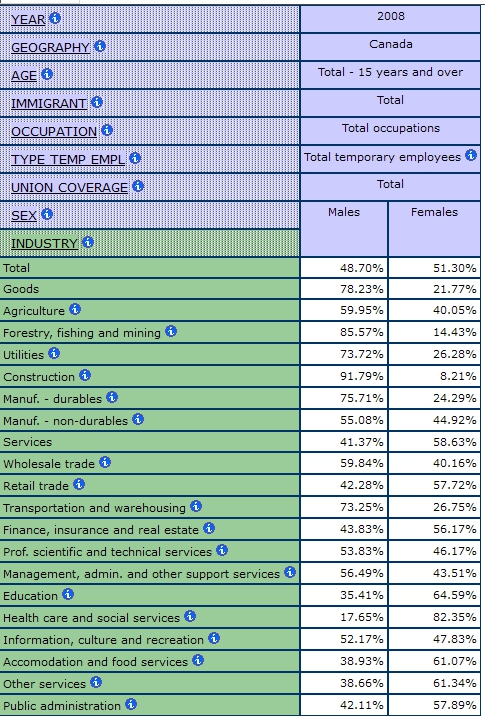
Table 1 illustrates the shares of men and women employed by industry. Women are over-representative in the health care and social services, education and retail industries. Men are highly concentrated in the goods producing industries, transportation and warehousing and wholesale trade industry. The second step is to examine the distribution of men and women by various sectors within the technology industry.
Table 2: Percentage of Men and Women in the Information Technology Industries, Total Employees, Canada, 2008
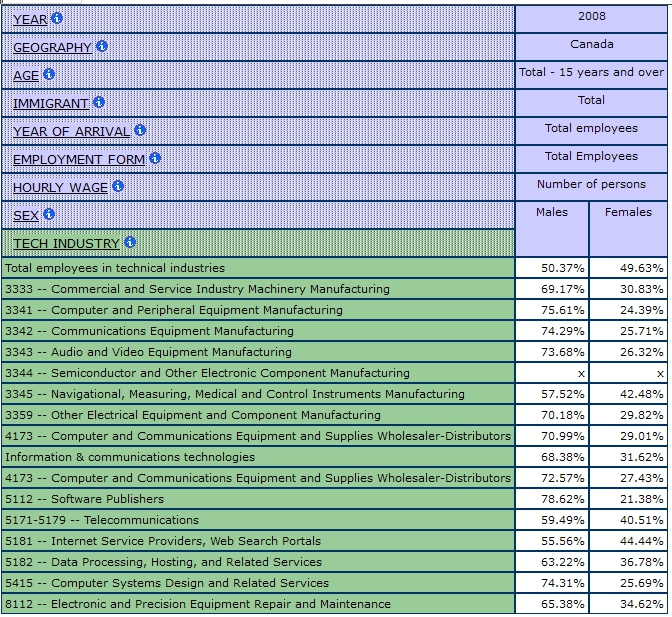
Note: Cells marked with an x indicate a suppressed value to ensure participant confidentiality.
Table 2 illustrates the percentage of men and women in each technology industry. As the specific sectors are examined more closely, one can see that the percentage of employed men exceeds the percentage of women within each category; hence, the gendering of specific technology industries as male-dominated.
Industry refers to the general nature of the business carried out in the establishment where a person works. The NAICS provides enhanced industry comparability among the three North American Free Trade Agreement (NAFTA) trading partners (Canada, United States and Mexico). This classification consists of a systematic and comprehensive arrangement of industries structured into 20 sectors, 99 subsectors and 300 industry groups. The criteria used to create these categories are input structures, labour skills and production processes used by the establishment.
The 2001 industry data can be tabulated for a number of populations, among which the most frequently used are: (a) the employed; (b) the experienced labour force – persons who were either employed or unemployed in the reference week but who had worked since January 1, 2000; (c) those who have worked since January 1, 2000, regardless of whether or not they were in the labour force in the reference week. The remaining components of the labour force, unemployed persons who worked prior to January 1, 2000, or who have never worked, are shown in the data under the category “Industry – Not applicable” (Statistics Canada, NAICS 2002).
The coding of industry was done using a pre-coded “List of Establishments” to ensure uniformity with the NAICS codes assigned to the same establishments by other Statistics Canada surveys. Comparable industry information based on the 1997 NAICS is available from the Labour Force Survey. The variable “Industry (based on the 1997 NAICS)” does not permit direct comparison to any previous census industry data. The 1980 Standard Industrial Classification should be used for comparisons between the 1986, 1991, 1996 and 2001 Censuses (Statistics Canada, NAICS, 2002).
The technology industries found in Table 2 were taken from The Special Aggregation for the Information and Communication Technology (ICT) Sector; based on the North American Classification System (NAICS) and developed by the Organization for Economic Co-operation and Development (OECD). The ICT Sector consists of industries primarily engaged in producing goods or services, or supplying technologies, used to process, transmit or receive information. The third step of the demonstration is to examine the distribution of workers within the technology industry by age group.
Table 3: Technology Industry by Age, Total Employees, Canada, 2008
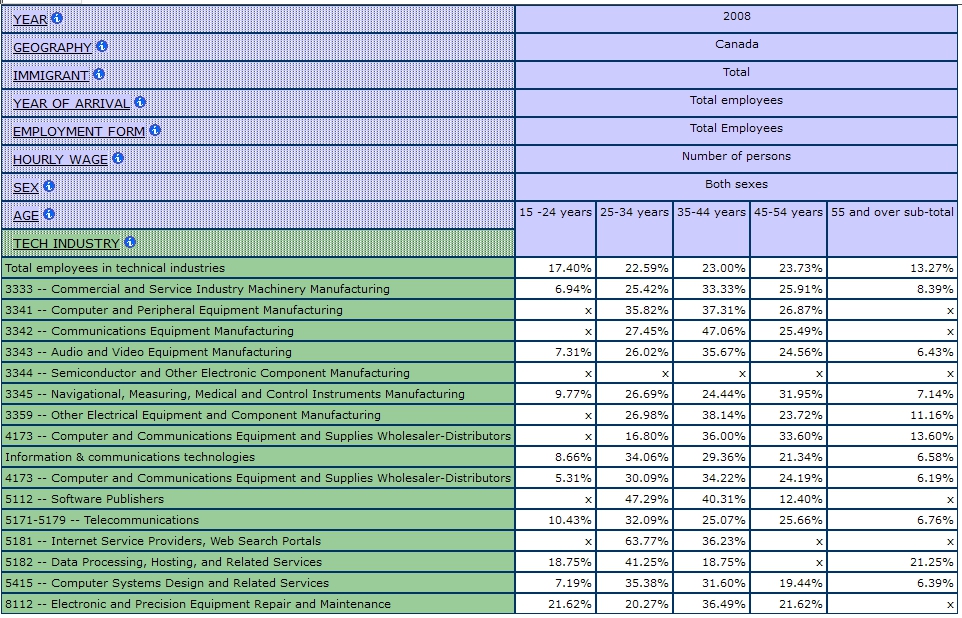
Table 3 demonstrates that the largest concentration of employees working in the technology industry are found within the 25-34 age range, followed by those between the ages of 35-44. With men and women combined, 64% of 25-34 year olds work in the internet services providers and web search portal sector, followed by 47% working in the software publishing sector.
Next, we examine immigrant status by technology industry. Dryburgh (2003; and with Hamel 2004) highlights the connection between migration and settlement patterns of information technology workers, noting that through the 1990s, over 60,000 IT workers migrated to Canada. However, as Dryburgh demonstrates in the case of science and engineering professionals, and others have demonstrated more broadly (Habtu 2003; Smith 2002), immigrants often experience wage inequities that are exacerbated by gender.
Table 4 demonstrates that, with men and women combined, there are higher shares of Canadian-born employees within each sector of the technology industry, as compared to employees born outside of Canada and are landed immigrants.
Table 4: Technology Industry by Immigrant Status, Total Employees, Canada, 2008
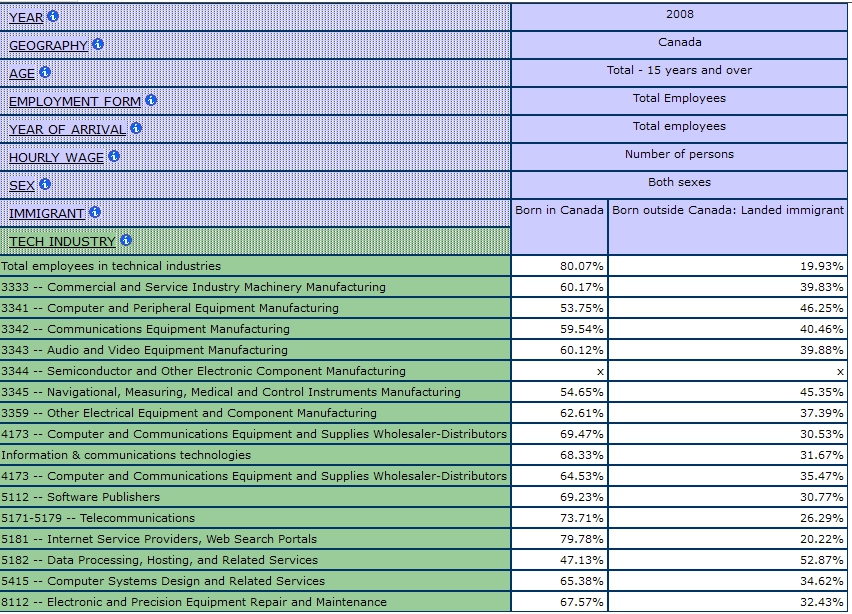
Part II: Hourly wage and social location in the technology industry
The second purpose of this demonstration is to examine the average hourly wage of those employed in the technical industry across social location, particularly sex and immigrant status.
The first step is to look at how hourly wage differs for men and women working in the technology industry.
Table 5: Average Hourly Wage by Sex and Technology Industry, Canada, 2008
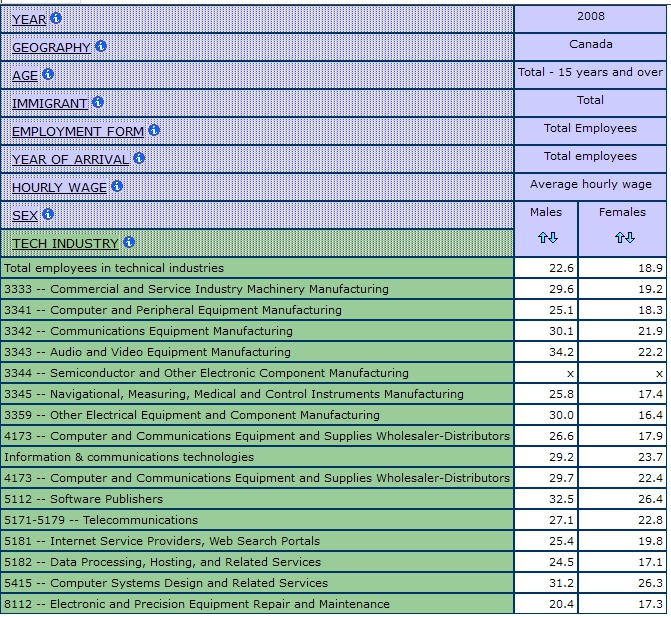
In Table 5 we can see that across all technology industries, men consistently receive a higher hourly wage compared to their female counterparts; where on average men are paid approximately $7.00 more than women.
Now that we have a starting point with the overview of average hourly wages, we drill down further and see what effects immigrant status has on the average hourly wage. This part of the demonstration explores how average hourly wage varies across sex and immigrant status.
Table 6: Average Hourly Wage by Sex, Immigrant Status and Technology Industry, Canada, 2008
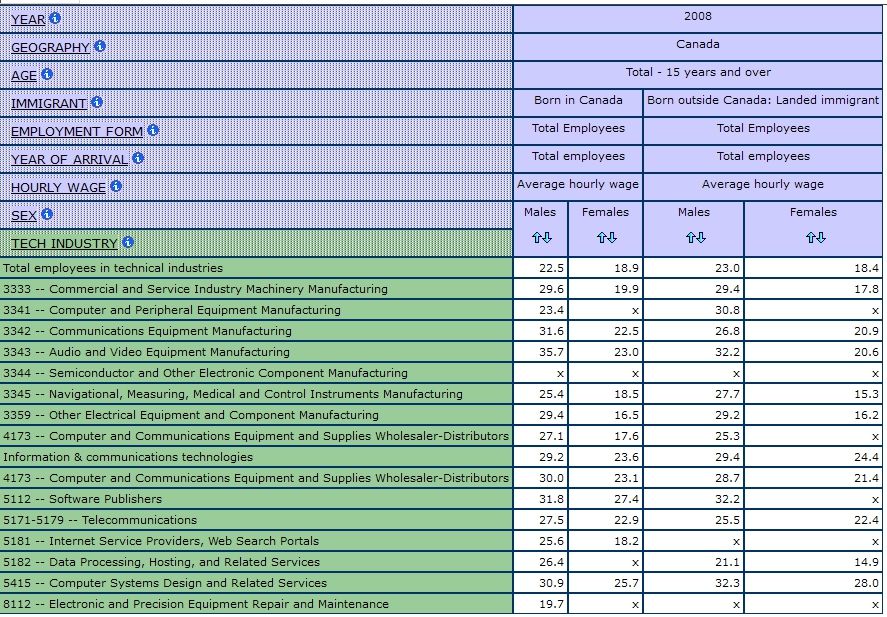
Table 6 demonstrates that generally speaking, men, born in Canada, earn a higher hourly wage than women employees born outside of Canada and classified as landed immigrants. However, it is interesting to note that in some technology industries, landed immigrants earn more than workers born in Canada. Landed immigrants, with men and women combined, earn a slightly higher hourly wage then their Canadian-born counterparts, specifically, those that work in the computer systems design and related services industry.
This demonstration illustrates the need to examine trends in the technology industry by social location, such as gender and immigrant status. The demonstration leads to questions that could be explored in more depth – such as how do these trends change when we divide the large information technology industry into the specific occupations within that industry? There are several other tables in the GWD that can aid users in exploring this and other questions.
DEMONSTRATION 2
Exploring the Information Technology Industry by Geography
The purpose of this demonstration is to see how technology workers are distributed amongst the Canadian provinces.
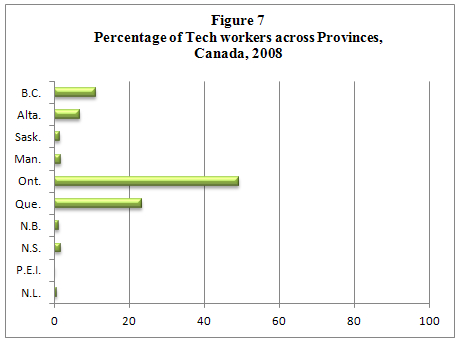
In Figure 7, we observe that the largest share of technology workers are in Ontario, nearly 50%. Quebec and British Columbia follow with the next largest shares. This analysis shows that technology, as an industry, is concentrated in Ontario. Keep in mind, of course, that Ontario is the largest province in Canada.
It would also be interesting for users to examine the percentage of workers in each province that work in technology. Which provinces have the largest concentrations of technology workforces out of their total workforces?
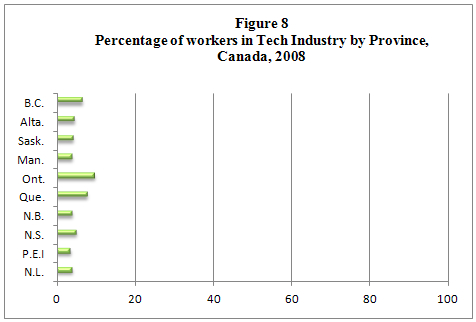
Note: Figure 8 was obtained by dividing the total number of employees in all tech industries by the total number of employees in all industries per province. The total number of employees in all tech industries is the sum of all tech industries found within the table TECH LFS D-1. The figure demonstrates that Ontario boasts the largest concentration of tech workers as a percentage of all workers in the province. Quebec and British Columbia follow with the next largest concentrations.
The demonstrations in this module underscore the need to examine social location within technology industry workforce in as detailed a manner as possible. The larger, more general trends can obscure what is really going on in the detailed layers beneath the aggregate data. The demonstrations are not only used as a method to help facilitate a practical understanding of how to use the statistical tables of the technology module, but also to unveil the many questions that could be explored in more depth. There are several other tables in the GWD that can aid users in exploring this and other questions.
WORKS CITED
Aneesh, A. (2006). Virtual Migration: The Programming of Globalization. Durham, NC: Duke University Press.
Armstrong, P. and Armstrong, H. (2001). The Double Ghetto: Canadian Women and their Segregated Work (2nd ed.). Toronto, ON: Oxford University Press.
Armstrong, P. and Armstrong, H. (2010). Wasting Away: the Undermining of Canadian Health Care. Don Mills: Oxford University Press.
Bain, P. and Taylor, P. (1999). “‘An Assembly Line in the Head’: Work and Employee Relations in the Call Centre.” Industrial Relations Journal, 30(2), 101-117.
Bain, P. and Taylor, P. (2000). “Entrapped by the ‘Electronic Panopticon’? Worker Resistance in the Call Centre.” New Technology, Work, and Employment, 15(1), 2-18.
Balka, E. (2002). “The Invisibility of the Everyday: New Technology and Women’s Work in Telecommunications in Atlantic Canada.” In Eileen Meehan and Ellen Riordan (Eds.), Sex and Money: Feminism and Political Economy in the Media. (pp. 60-74). Minneapolis: University of Minnesota Press.
Balka, E., Green, E. and Henwood, F. (2009). Gender, Health, and Information Technology in Context. Hampshire: Palgrave Press.
Belt, V., Richardson, R. and Webster, J. (2000). “Women’s Work in the Information Economy: The Case of Telephone Call Centres.” Information, Communication, and Society, 3(3), 366-385.
Berner, B. (1997). Gendered Practices: Feminist Studies of Technology and Society. Linkoping, Sweden: Department of Technology and Social Change.
Brophy, E. and de Peuter, G. (2007). “Immaterial Labor, Precarity, and Recomposition.” In Catherine McKercher and Vincent Mosco (Eds.), Knowledge Workers in the Information Society. (pp. 177-191). Lanham, MD: Lexington Books.
Brophy, E. (2009). “Resisting Call Centre Work: The Aliant Strike and Convergent Unionism in Canada.” Work Organization, Labour and Globalization, 3(1), 80-99.
Browne, P. L. (2000). Unsafe Practices: Restructuring and Privatization in Ontario Health Care. Ottawa: Canadian Centre for Policy Alternatives.
Buchanan, R. and Koch-Schulte, S. (2000). Gender on the Line: Technology, Restructuring and the Reorganization of Work in the Call Centre Industry. Ottawa, Ontario: Status of Women Canada.
Canadian Conference of the Arts. (2008). Framework for Creative Labour.
Castells, M. (1996). The Rise of the Network Society: The Information Age: Economy, Society and Culture, Volume 1. Cambridge, MA: Blackwell Publishers.
Christopherson, S. and van Jaarsveld, D. (2005). “New Media After the Dot.com Bust.” International Journal of Cultural Policy, 11(1), 77-93.
Collin-Jacques, C. and Smith, C. (2005). “Nursing on the Line: Experiences from England and Quebec (Canada).” Human Relations, 58(1), 5-32.
Crow, B. and Longford, G. (2000). “Digital Restructuring: Gender, Class, and Citizenship in the Information Society in Canada.” Citizenship Studies 4(2), 207-230.
Crow, B. and Longford, G. (2003). “From the Electronic Cottage to the Silicon Sweatshop: Social Implications of Telemediated Work in Canada.” In Maria Bakardjieva, Frits Pannekoek, and David Taras (Eds), How Canadians Communicate. (pp. 275-305). Calgary, Alberta: University of Calgary Press.
Dryburgh, H. (June 2003). “Immigrant Science and Technology Workers: Employing the Brain Gain?” Paper presented at the Congress of the Social Sciences and Humanities, Halifax.
Dryburgh, H. and Hamel, J. (Autumn 2004). “Immigrants in Demand: Staying or Leaving?” Canadian Social Trends, 74, 12-17.
Economic and Industrial Democracy. (2001). Special Issue 22(1).
Ferus-Comelo, A. (2006). “Double Jeopardy: Gender and Migration in Electronics Manufacturing.” In Ted Smith, David Sonnenfeld and David Pellow (Eds.), Challenging the Chip: Labor Rights and Environmental Justice in the Global Electronics Industry. (pp. 43-54). Philadelphia: Temple University Press.
Franklin, U. (1999). The Real World of Technology. Toronto, Ontario: Anansi Press.
Gill, R. (2002). “Cool, Creative and Egalitarian? Exploring Gender in Project-Based New Media Work in Europe.” Information, Communication, and Society, 5(1), 70-85.
Gollmitzer, M. and Murray, C. (2009). “Workflows and Flexicurity: Canadian Cultural Labour in the Era of the Creative Economy.” Centre of Expertise on Culture and Communities. Click here for PDF document.
Gregg, M. (2008). “The Normalization of Female Flexible Labour in the Information Economy.” Feminist Media Studies, 8(3), 285-299.
Gurstein, P. (2001). Wired to the World, Chained to the Home: Telework in Daily Life. Vancouver, BC: University of British Columbia Press.
Habtu, R. (2003). “Information Technology Workers.” Perspectives on Labour and Income, 15(3).
Harvey, D. (1989). The Condition of Postmodernity: An Enquiry into the Origins of Cultural Change. Oxford, UK; Cambridge, Mass.: Blackwell.
Holman, D., Batt, R. and Holtgrewe, U. (2007). The Global Call Centre Report: International Perspectives on Management and Employment (UK Format). Report of the Global Call Centre Network.
http://www.ilr.cornell.edu/globalcallcenter/upload/GCC-Intl-Rept-UK-Version.pdf
Human Resources and Skills Development Canada. (2011). Introduction to Edition 2001 of the National Occupational Classification (NOC).
Huws, U. (2003). The Making of a Cybertariat: Virtual Work in a Real World. New York: Monthly Review Press.
Illich, I. (1981). Shadow Work. Boston: M. Boyars.
Johnson, L. C. (2004). The Co-Workplace: Teleworking in the Neighbourhood. Toronto and Vancouver: University of British Columbia Press.
Kotamraju, N. P. (2002). Reach Out and Write Someone.” Contexts, 1(4), 10-11.
Leonard, E. (2003). “The Social Construction of Technology.” In Eileen B. Leonard (Ed.), Women, Technology and the Myth of Progress. (pp. 13-26). New Jersey: Prentice-Hall.
Machlup, F. (1962). The Production and Distribution of Knowledge in the United States. Princeton: Princeton University Press.
Martin, M. (1991). ‘Hello, Central?’ Gender, Technology and Culture in the Formation of Telephone Systems. Montreal: PQ McGill-Queen’s University Press.
McLaren, L. (2002). “Information and Communication Technologies in Rural Canada.” Rural and Small Town Analysis Bulletin. Ottawa: Statistics Canada, 3(5). http://publications.gc.ca/Collection/Statcan/21-006-X/21-006-XIE2001005.pdf
McLaughlin, J. (1999). “Gendering Occupational Identities and IT in the Retail Sector.” New Technology, Work, and Employment, 14(2), 143-156.
Menzies, H. (1996). Whose Brave New World? The Information Highway and the New Economy. Toronto, Ontario: Between the Lines.
Menzies, H. (1997). “Telework, Shadow Work: The Privatization of Working in the New Economy.” Studies in Political Economy, 53, 103-123.
Menzies, H. (2005). No Time: Stress and the Crisis of Modern Life. Vancouver, BC: Douglas & McIntyre.
Millar, M. (1998). Cracking the Gender Code: Who Rules the Wired World? Toronto: Second Story Press.
Mulholland, K. (2002). “Gender, Emotional Labour and Teamworking in a Call Centre.” Personnel Review, 31(3), 283-303.
Noble, D. (1995). Progress without People: New Technology, Unemployment, and the Message of Resistance. Toronto, Ontario: Between the Lines.
Organization for Economic Cooperation and Development. (1981). “Information Activities, Electronics, and Telecommunications Activities: Impact on Employment, Growth, and Trade.” Information, Computer Communications Policy Series, Volume 1, Paris OECD.
Park, L. S. H. and Pellow, D. (2002). The Silicon Valley of Dreams: Environmental Injustice, Immigrant Workers, and the High-Tech Global Economy. New York: New York University Press.
Porat, M. U. (1977). “The Information Economy: Definition and Measurement.” Special Publication – Office of Telecommunications. Washington, DC: US Department of Commerce, 1, 77-21.
Pupo, N. and Noack, A. (2009). “Standardising Public Service: The Experiences of Call-Centre workers in the Canadian Federal Government.” Work Organization, Labour and Globalization, 3(1), 100-113.
Reich, R. (1991). The Work of Nations: Preparing Ourselves for 21st-Century Capitalism. New York: Vintage Books.
Ross, A. (2009). Nice Work If You Can Get It: Life and Labor in Precarious Times. New York: NYU Press.
Scott-Dixon, K. (2004). Doing IT: Women Working in Information Technology. Toronto: Sumach Press.
Smith, E. and Jackson, A. (2002). Does A Rising Tide Lift All Boats? The Labour Market Experiences and Incomes of Recent Immigrants, 1995 to 1998. Ottawa: Canadian Council on Social Development.
Statistics Canada. (2007). Introduction to the National Occupational Classification for Statistics. http://www.statcan.gc.ca/subjects-sujets/standard-norme/soc-cnp/2006/noc2006-cnp2006-introduction-eng.htm
Statistics Canada. (2011). Variant of NAICS 2007: Information and Communication Technology (ICT) Sector, based on the 1998 OECD definition of the ICT Sector. http://www.statcan.gc.ca/subjects-sujets/standard-norme/special/ict2007-tic2007/intro-1998-eng.htm
Statistics Canada. (2011). Special Aggregation: Information and Communication Technology (ICT) Sectors.
http://www.statcan.gc.ca/concepts/industry-industrie-eng.htm
Statistics Canada. (2011). Variant: Information and Communication Technology (ICT) Sector. http://www.statcan.gc.ca/concepts/definitions/intro02-eng.htm
Streeck, W. (1992). Social Institutions and Economic Performance: Studies of Industrial Relations in Advanced Capitalist Economies. London: Sage Publications.
Terranova, T. (2004). “Free Labour.” In Tiziana Terranova (Ed.), Network Culture: Politics For The Information Age. (pp. 73-97). London: Pluto Press.
van den Broek, D. (2008). “‘Doing Things Right’, or ‘Doing the Right Things’? Call Centre Migrations and Dimensions of Knowledge.” Work, Employment & Society, 22(4), 601-613.
van Jaarsveld, D., Frost, A. and Walker, D. (2007). “The Canadian Contact Centre Industry: Strategy, Work Organization, and Human Resource Management.” The Global Call Centre Industry Project, Vancouver, BC.
Xiang, B. (2007). Global “Body Shopping”: An Indian Labor System in the Information Technology Industry. Princeton, New Jersey: Princeton University Press.>
